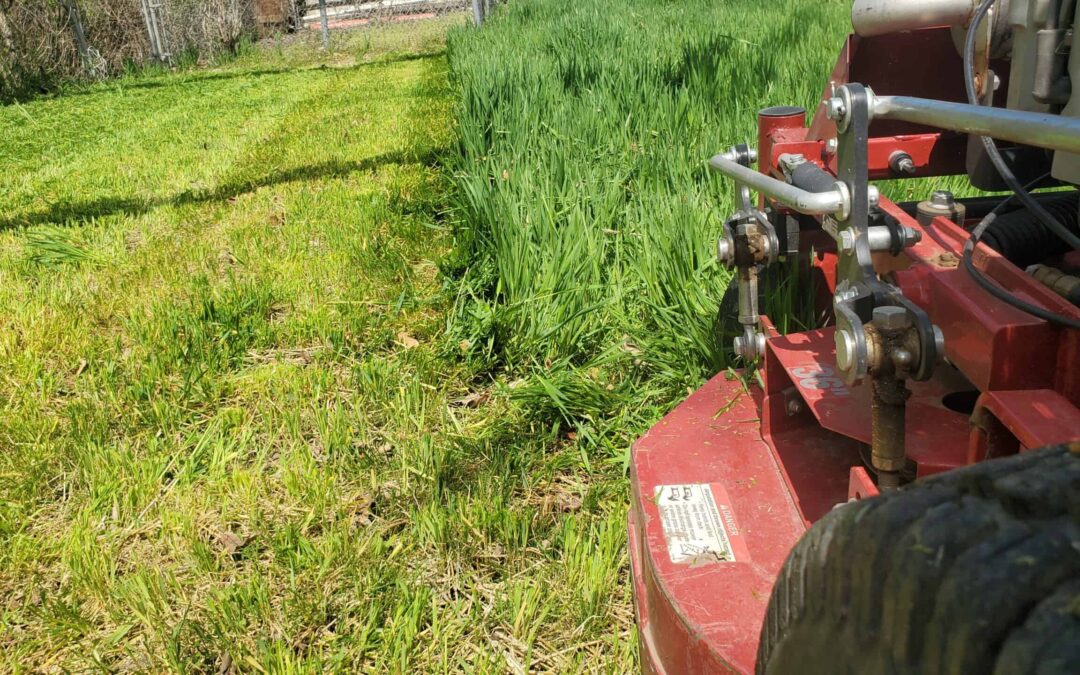We should talk about mowing. It’s not like there’s any snow to talk about, or freezing rain, or even a little ice. Mowing it is!
Despite the season for frozen precipitation, mowing plays a big part in the life of your garden. It’s one of the first tasks done after the snow melts (if there is snow) and one of the last tasks done before preparing the lawn for winter. And, you may not have noticed, but it’s cut different lengths with seasonal changes.
Air temperature, availability of shade, and water supplies all play a part in the length your grass is cut when your landscaping team at Divine Lawns is manicuring your emerald acres.
Your Divine Lawns expert probably had one last mow some time at the end of the fall season. Maybe you noticed that they were leaving a light coating of clipped grass to cover your lawn. That clipped grass acts as an insulating blanket when the air gets cold enough to freeze water drops and small unwary insects.
Talking ‘Bout That Mulch
In addition, you probably have a thick layer of mulch, made up of raked leaves and other organic elements, around the garden and bedding plants that have been allowed to remain outdoors during the winter season. There are also probably piles around the trees and the roots and lower branches of bushes.
These beds of mulch insulate the ground and roots of the plants, so freezing rain or cold northern winds that sweep across the vast plains around Kansas won’t change the temperatures of the soil or roots, allowing your plants to stay healthy.
Kansas climate dictates that our mowing season starts every year in mid-March. Giving your lawn a slight clipping for the first mowing event will expose the grasses to the air and water gathered everywhere snow melted. The clipped tops will probably be gathered, along with the tops of the grass from the last mowing before the expected, but late, snow.
Your lawns will be carefully checked for diseases that grassy plants are subject to, like snow mold. The grass, roots, and soil will be treated or removed if found. Then, those areas will be replaced with soil and seeds and observed till they blend into the rest of your lawns.
There are different grasses for different seasons and uses. If your lawn gets a lot of use by your children and family, tougher grass might be planted, so it stands a better chance of surviving. Before winter, your lawn and garden people might decide to overseed a little with a more hardy grass that can stand up to the months of being buried under a blanket of mulch and snow.
The First Scents of Spring
The first mowing of spring! Can you smell it? The heady, almost spicy smell of the mown grass! And the piles of used mulch that’s started to decompose? Maybe not very appealing as a smell, but it is a spring smell.
Your yard and garden will undoubtedly need quite a bit of cleanup during that first part of spring. Even if the weather has denied you the heavy snowfall of your neighbors to the north, there are still things to be done. Places where paths were shoveled and snow piled up might need a little help to thaw out entirely by removing some of the heavy snow.
Deicers will have to be swept up and disposed of to prevent any of it from getting into your lawn and plants. Next, mulch is removed and replaced. Tired flower or plant beds that didn’t do well in the winter months will be dug up and replanted, an excellent time to decide if you’d like a change of color for the blossoms of your bedding plants. But it’s the mowing and the smell of new grass that’s incredibly appealing.
Your Divine Lawns team will probably apply a light fertilizer coating on the beds and lawns. Some will be sprinkled on the tree and shrub roots, gently urging them to grow and flourish. This first coating will help your lawns and gardens wake up, smell the… well, and smell the other blooming flowers and trees.
It will encourage the growth and deeper penetration of new roots and stalks. Soon, your gardens and lawns will be proudly waving taller stalks in the breezes. And your lawns will need another mowing.
Taking a Closer Look
Your trees and other woody plants will be inspected. If it ever comes, snow is heavy and can further damage tree branches already splitting where they joined the tree or plant. Those will need to be removed as they are a safety hazard to you and your family, guests, house, and property.
Other inspections will occur during the following weeks: sprinkler and irrigation systems will be checked for split pipes or hoses before being reset. Outside pipes will be unwrapped from the insulation applied in the fall and inspected. Container gardens will also be checked to ensure the plants have plenty of room to grow. So much to do!
It will be something of a relief when your regular schedule of lawn and garden care is restarted. In addition, you might want to consider a pressure wash for the outside of the house, the paved areas, and your family’s outdoor activities areas.
If your family is very active in backyard sports, like tennis, badminton, or basketball, it’s a good time to check nets, hoops, racquets, balls, and other sports equipment. In addition, kids playing hopscotch will need new pavement chalk for home and school.
Taken all together, your home has a busy time after the (expected) snow melts. Spring brings new and exciting things to your yards and gardens and allows you to change or rearrange things that need attention. In every way, your home is refreshed and ready for the coming seasons until the next snow is due.
 (316) 435-3509
(316) 435-3509 office@divine-lawns.com
office@divine-lawns.com
